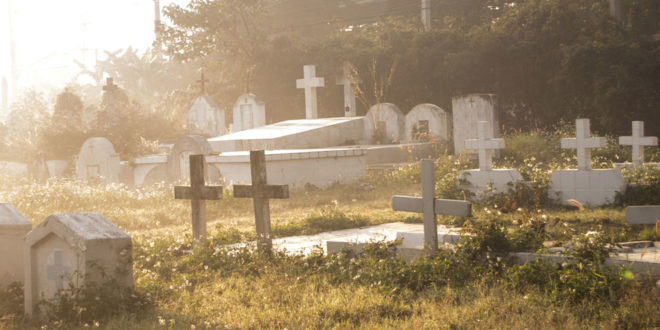On the first day of my grandson’s spring break from school, I offered to pick him up from a parent’s office by early afternoon for an overnight stay. Or he could come with me and a friend that morning to visit a cemetery before going to my house. I was fulfilling a promise to my cousin’s wife who had asked me to visit a cemetery in our state to take a photo of her great-aunt’s grave headstone. The year before she had sent me the name of all the family members in a certain section and row at the cemetery. My cousin had purchased a headstone to mark the aunt’s grave but she had never seen it.
My son suggested that I ask Grandson if he wanted to go with us, and the seven-year-old replied, “O.K., I’ll go.” The cemetery would be a first for him. I wondered if he would be bored, disgusted, or overly active after a long ride.
A Visit to the Cemetery
So the three of us set off with the Waze app to find a cemetery about 60 miles away from our city. My grandson sat in the back seat reading Garfield books while the adults chatted and watched for road changes. Finally we arrived at the big cemetery without a clue as to how to find one specific headstone. I had talked to the sexton’s assistant that morning, but he was not in his office and didn’t answer his phone upon our arrival.
I decided we should drive around and see if he might be working outside. In the distance we could hear a bagpipe playing. We could see from the cars that a funeral was in progress. At the edge of the funeral a man stood near a small earth mover. My friend walked out to the field to see if that was our man. Sure enough, he recognized the name and directions we had so we followed him right to the row. Then I was able to take a photo of the woman’s headstone. Mission accomplished!
After finding the headstone and a quick Facebook send, my grandson wanted to look around. He started noticing the family names on other headstones, the various sizes, shapes, and inscriptions. “Oh look, it says Clifford,” he remarked. Later he read the age of one of the children who had died, “She was four years old.” I was getting anxious to go find the restaurant for lunch, but Grandson wanted to see more sections of the cemetery. So we moved the car and walked through some more rows, trying to find the very oldest headstones for dates. I told him how some people make paper tracings of headstone names to take home. We noticed a lot of WWII veterans graves, elaborate modern headstones, epitaphs, mausoleums, and graves decorated with a flurry of fading artificial flowers.
Family Tradition
I remembered our family tradition of putting flowers on ancestors’ graves before Memorial Day. My paternal grandma called the national holiday “Decoration Day” since that was when respectful families visited cemeteries and remembered their loved ones. She would always pick “snowball bush” flowers from the front yard for grandfather’s grave as she said that was his favorite flower. We would buy plants such as geraniums and Dad would dig a hole behind the headstones to place the flowers. Great-grandparents and some aunts’ and uncles’ graves could be found in the same cemetery. Grandma seemed to know a lot of people there. As children, we were cautioned not to run around, or even walk on the tops of the gravesites. It was an intriguing, yet strange, sort of community.
One result of a very mobile society is that very few people live around the cemeteries where they have ancestors buried or interred. Often people choose to have their ashes delivered to favorite places on earth or water. I think most people would like to have someone know their names and the dates of their existence—that they mattered. Perhaps that is one reason that people now visit ancestors’ burials on Find-a-Grave or other internet research genealogy sites.
Connected to Heritage
I mentioned to my grandson that some of the headstones we were seeing had family names that were included in his heritage, even if they weren’t our people. I want my grandchildren to feel connected to a long line of people in the past and all that they endured to bring us forth. So I reminded him that he had attended his great-grandfather’s funeral when he was a toddler, even though he can’t remember the occasion. I promised him that I would take him to see family headstones if we were together in my former home state.
I am so thankful that my God doesn’t forget my existence nor my loved ones. Perhaps my grandson won’t forget the spring break when he first visited a cemetery.
Questions for personal journaling or group discussion:
- Read Romans 8:38, 39. What does that mean to you?
- How might you honor a parent, grandparent, or deceased mentor in a very practical way?
Karen Spruill writes from Florida.
© 2002 - 2025, AnswersForMe.org. All rights reserved. Click here for content usage information. Answers for Me Support & encouragement for every-day life
Answers for Me Support & encouragement for every-day life



